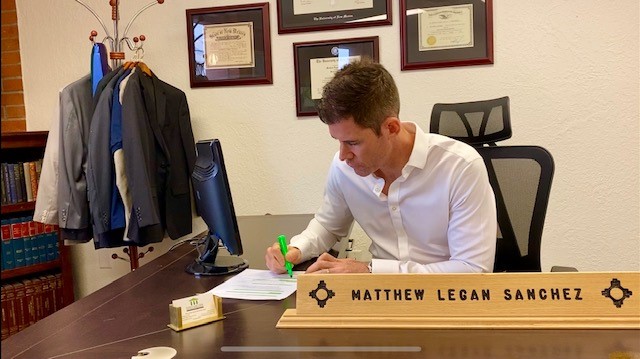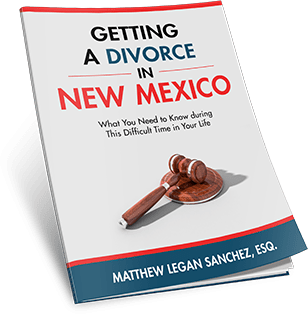
Setting Aside a Default Divorce or Court Order in Albuquerque New Mexico
CAN A DEFAULT JUDGMENT OF DIVORCE BE SET ASIDE IN NEW MEXICO?
I frequently field questions regarding one’s ability to set aside a bad judgment or court order. In some situations a default order was entered against one’s interests based on the failure to appear in court, or the failure to file a timely responsive pleading. In other situations, one comes to the realization that they entered a horrible agreement based on mistake, excusable neglect, fraud, misrepresentation, or misconduct.
THE COMMON PATHS TO REACH YOUR GOAL OF SETTING ASIDE A DEFAULT DIVORCE
There are two common paths that one can travel towards setting aside a default divorce or court order in Albuquerque, New Mexico. The first path involves appealing the court’s ruling when it is based on an abuse of discretion. “An abuse of discretion is defined as a decision that is ‘clearly against the logic and effect of the facts and circumstances before the [trial] court.’” State v. Chandler, 119 N.M. 727, 733. An appeal must be filed within the requisite 30 day period. In many situations the 30 day window of opportunity to file an appeal has either closed, or the order at issue is more appropriately handled by filing a Rule 60(b) Motion to Set Aside.
RULE 60(b) MOTION TO SET ASIDE A DEFAULT DIVORCE IN NEW MEXICO
A Rule 60(b) Motion to Set Aside asks the Court to set aside a court order or judgment in the interest of equity and fairness. Rule 60(b) balances the need for finality of judgments with the need for relief against unjust judgments.
In Ruling on a motion under Rule 60(b) the trial court has discretion, within the confines of justice, to decide and act in accordance with what is fair and equitable. Harkins v. Harkins, 101 N.M. 296, 184 NMSC 57.
The most common reasons for relief under rule 60(b) include: (1) Mistake, inadvertence, surprise or excusable neglect; (2) Newly discovered evidence; (3) Fraud, misrepresentation, or other misconduct. See Rule 1-060(B) NMRA.
A Motion to Set Aside based on any of the reasons above must be filed within one year after the Order was entered.
When more than one year has passed since the Order was entered, one must prove the existence of an exceptional circumstance that warrants expanding the one year requirement. It is important to note that one cannot file a Motion to Set Aside claiming mistake, fraud, neglect, misrepresentation – or any of the elements under (1) – (3) above, and also claiming “exceptional circumstances” in an attempt to circumvent the one year requirement. In other words, the basis for one’s claim to set aside a court order cannot be both mistake, fraud, neglect, misrepresentation, etc., and also exceptional circumstances.
NEW MEXICO CASES THAT DISCUSS SETTING ASIDE A DEFAULT DIVORCE
Let’s examine a handful of New Mexico cases that clarify the law surrounding one’s ability to set aside a court order under Rule 60(b).
The New Mexico Supreme Court case, Wehrle v. Robinson, 1979 NMSC 16, involved a Rule 60(b) Motion to Set Aside that was filed more than one year after a court order was entered. In Wehrle, the Husband to a divorce asked the Court to set aside the couple’s Final Decree of Divorce. Husband claimed that a mistake was made when entering into the Marital Settlement Agreement (i.e. the agreement distributing community property and debt) and the resulting Final Decree. In particular, Husband claimed that he mistakenly assumed more debt than required under New Mexico law, and that the resulting Final Decree should be set aside in equity and fairness. Because more than one year had passed since entry of the Order, Husband claimed that both “mistake” and “exceptional circumstances,” were present. The Court ultimately rejected Husband’s attempt to set aside the Court Order, based on the fact that the Motion to Set Aside was filed more than one year after the Final Decree was entered. The court reasoned: “If one is arguing mistake, fraud, misrepresentation, etc. he cannot circumvent the one-year limit set out in Rule 60(b) by claiming he is seeking relief under part (6).” Id. at 635. Because the basis for Husband’s request to set aside the Oder was based on mistake, his Motion to Set Aside was denied because the motion was not filed within the one year time limit.
Similarly, in Edens v. Edens, 137 N.M. 207, Husband agreed to provide wife with a lump sum amount of non-modified alimony, based on what he believed was the parties’ projected, future incomes after the divorce. As it turned out, Husband overestimated his future income, while underestimating Wife’s income. Husband filed a Motion to Set Aside arguing that the lump sum alimony agreement should be set aside because of Wife’s misconduct. In particular, Husband claimed that Wife misrepresented her income during the meditations leading to the lackluster alimony agreement. The New Mexico Court ultimately ruled that Husband “. . . made a free and conscious choice when he suggested lump sum alimony . . . . [and] rule 60(b) is not to be invoked to give relief to a party who has chosen a course of action which in retrospect appears unfortunate.” Id. at 22. In addition to claiming misrepresentation, Husband also claimed “exceptional circumstances.” The court ruled that the basis for Husband’s motion did not establish exceptional circumstances that would expand the one year limitation. The Court also ruled that one is unable to claim both misrepresentation and exceptional circumstances. In the end, Husband’s attempts to set aside the agreement surrounding lump sum alimony was denied.
The Court’s ruling in Edens is similar to Garcia v. Garcia, (N.M. App., 2013), No. 32,741. In Garcia, Wife filed a Rule 60(b) Motion to Set Aside the Marital Settlement Agreement and Final Decree of Dissolution. Wife claimed that she did not receive a large enough slice of community property in the parties’ Agreement. Wife’s Motion to Set Aside was filed more than one year after the Final Decree of Dissolution was entered, and was based on allegations of fraud, misrepresentation, and exceptional circumstances. The Court denied Wife’s motion to set aside, reasoning that Wife’s motion to set aside – which was actually based on fraud and misrepresentation — was filed well after the one-year time limit had expired. Wife argued that exceptional circumstances were present, in additional to fraud and misrepresentation. The court ruled that one may not claim exceptional circumstances when the basis for one’s claim is actually grounded in fraud, misrepresentation, mistake, etc. One cannot claim exceptional circumstances in order to circumvent the one year statute of limitation imposed on filing a Motion to Set Aside based on fraud, misrepresentation, mistake, etc. The court ruled that Wife was essentially repackaging the claims of fraud under the label of “exceptional circumstances.” In denying Wife’s Motion to Set Aside, the court reasoned: “[Wife] simply wanted a re-division because she received a bum deal.” Id. at 4.
HAS OVER ONE YEAR PASSED SINCE YOUR DEFAULT DIVORCE WAS ENTERED?
When over one year has passed since the Order was entered, the relevant question becomes: “What qualifies an exceptional circumstance allowing one to file a Motion to Set Aside after one year, but within a reasonable amount of time?”
In Dyer v. Pacheco, 98 N.M. 670 the court set forth a much needed definition, stating that: “Exceptional circumstances means facts or things out of the ordinary bearing upon a central fact.”
Unfortunately, the definition supplied by Dyer v. Pacheco leaves much to one’s imagination (not to mention future litigation) in the way of providing a clear definition of “exceptional circumstances.”
A separate New Mexico case provides needed clarification regarding Pacheco’s ambiguous definition of exceptional circumstances.
The New Mexico Court of Appeals examined whether exceptional circumstances were present, in State ex rel. Human Servs. Dep’t v. Rawls, 2012-NMCA-052. In this case, Rawls agreed that he was the biological father of the minor child at issue. A court order was entered finding Rawls to be the child’s biological father, entering judgment for retroactive child support, and establish ongoing child support. After several years had passed it was determined through DNA testing that Rawls was not the child’s biological father. Rawls filed a Rule 60(b) Motion to Set Aside the Orders establishing paternity and assessing child support. The trial court denied Rawls’ Motion because the one year statute of limitations for filing the Motion had passed. Rawls appealed the court’s decision, claiming that exceptional circumstances were present that allowed the court to expand the one year requirement. The court of appeals ultimately held that the case’s unique facts presented an example of “exceptional circumstances.” The court reasoned that: “. . . [W]e think that the change from a mistaken admission of paternity to proof of non-paternity qualifies as extraordinary change of circumstance sufficient to permit rule 1-060(B)(6) relief from a child support obligation.” Id. at 17.
Let’s apply the law outlined above towards “real life” scenarios that I typically encounter.
The first “real world” example involves court orders that are entered by default. The default order can come because one fails to appear in court, or fails to file a responsive pleading on time. Because the court disfavors default judgments and prefers to resolve cases on the merits, the court will generally overturn a default order when the Motion to Set Aside is filed within one year. As illustrated above, it is exceedingly difficult to demonstrate the “exceptional circumstances” necessary to expand the one year requirement. The court makes it difficult to file a Motion to Set Aside after one year has passed because of the competing needs for relief against unfair judgments, balanced with the need for finality of judgments and endless re-litigation of issues.
The second common scenario involves a person attempting to set aside a “bum deal.” Possibly one rushed through a divorce and signed papers without closely examining the actual agreement or fine print. Potentially one was duped into a bum agreement through fraud, duress, misrepresentation, or some other shady act. In any event, as illustrated above, one has a burden to discover and address the issue within one year. In other words, speak now – or after one year has passed you will forever hold your peace.
(505) SANCHEZ IS HERE TO ANSWER ALL OF YOUR QUESTIONS ABOUT SETTING ASIDE A DEFAULT DIVORCE OR COURT ORDER IN ALBUQUERQUE, NEW MEXICO
Do you still have questions about setting aside a default divorce or court order in Albuquerque, New Mexico? Complex divorce issues in Albuquerque often require the experienced hand and knowledge that comes with years of courtroom practice. Matthew Legan Sanchez is an experienced default divorce attorney in New Mexico that handles default divorces in Albuquerque. Sanchez can be reached by calling (505) SANCHEZ.

Setting Aside a Default Divorce or Court Order in Albuquerque New Mexico






